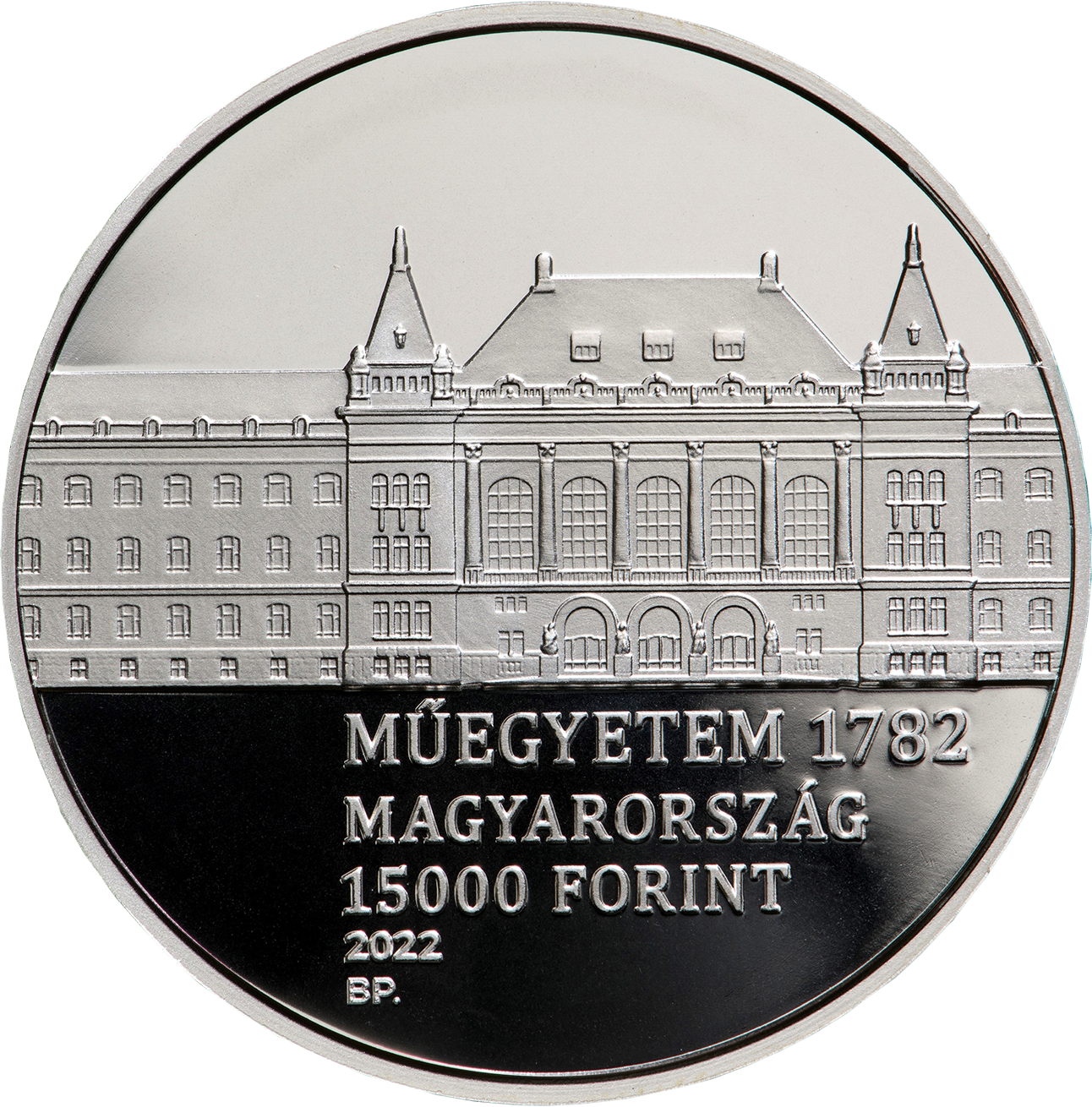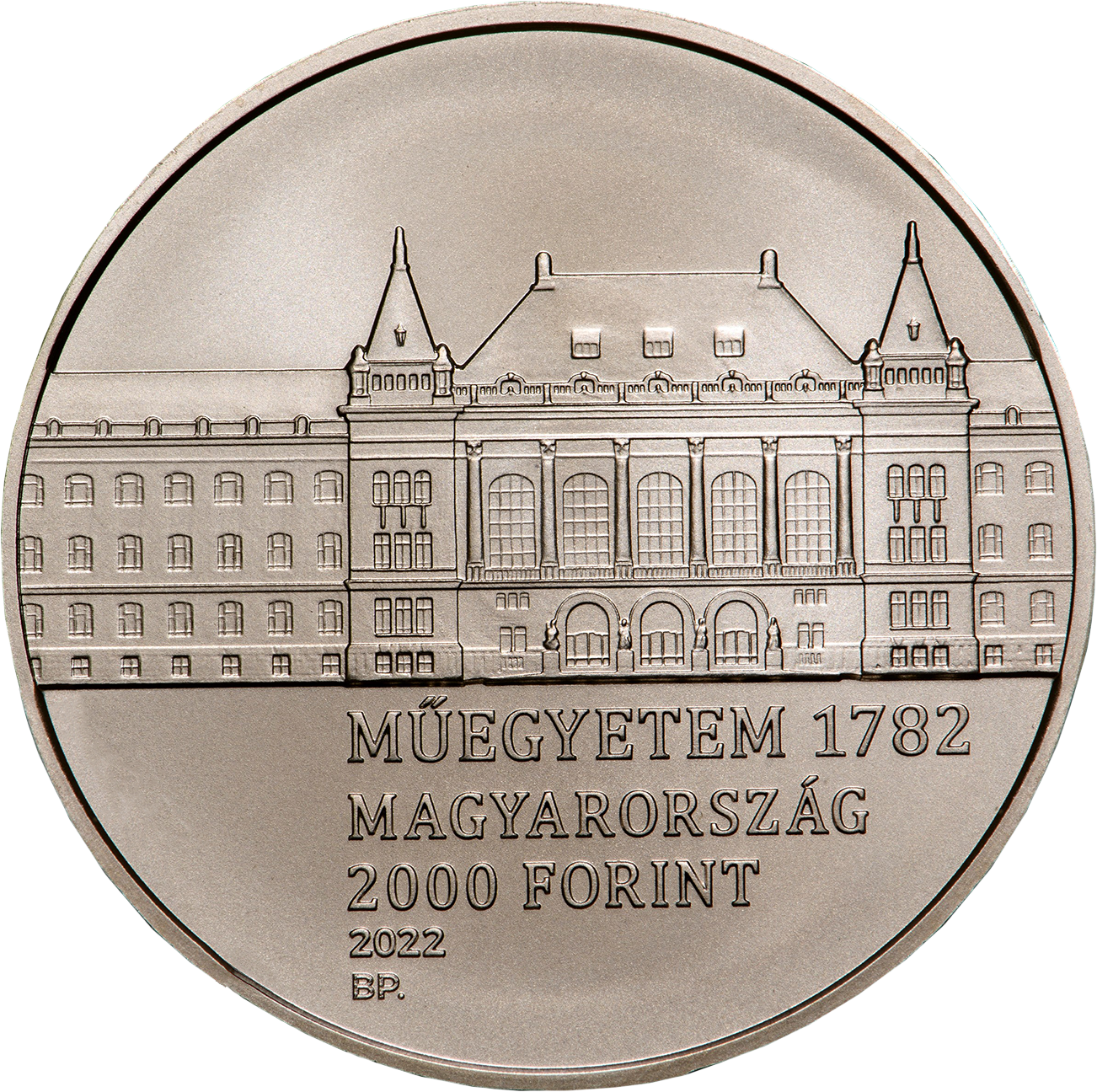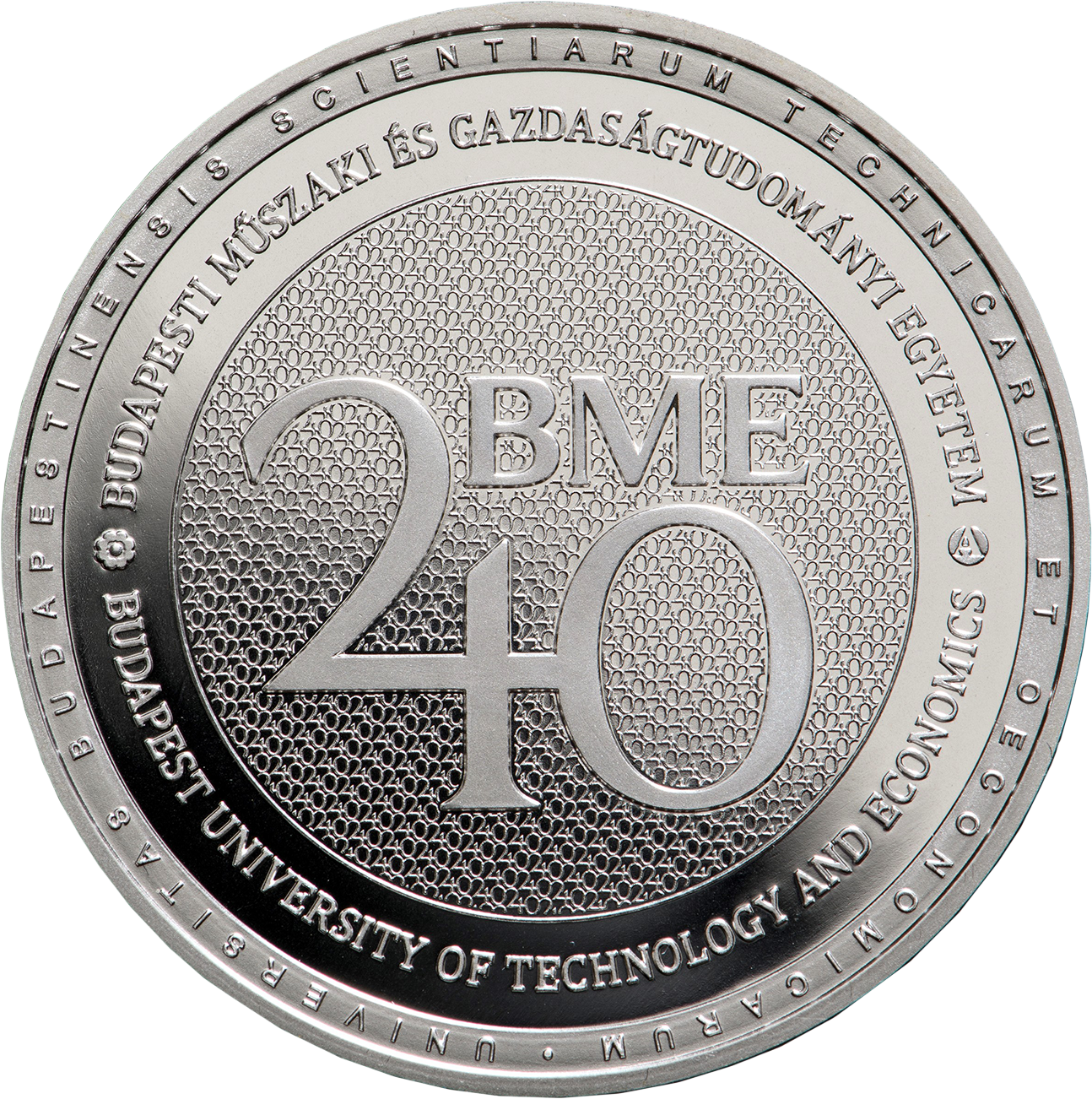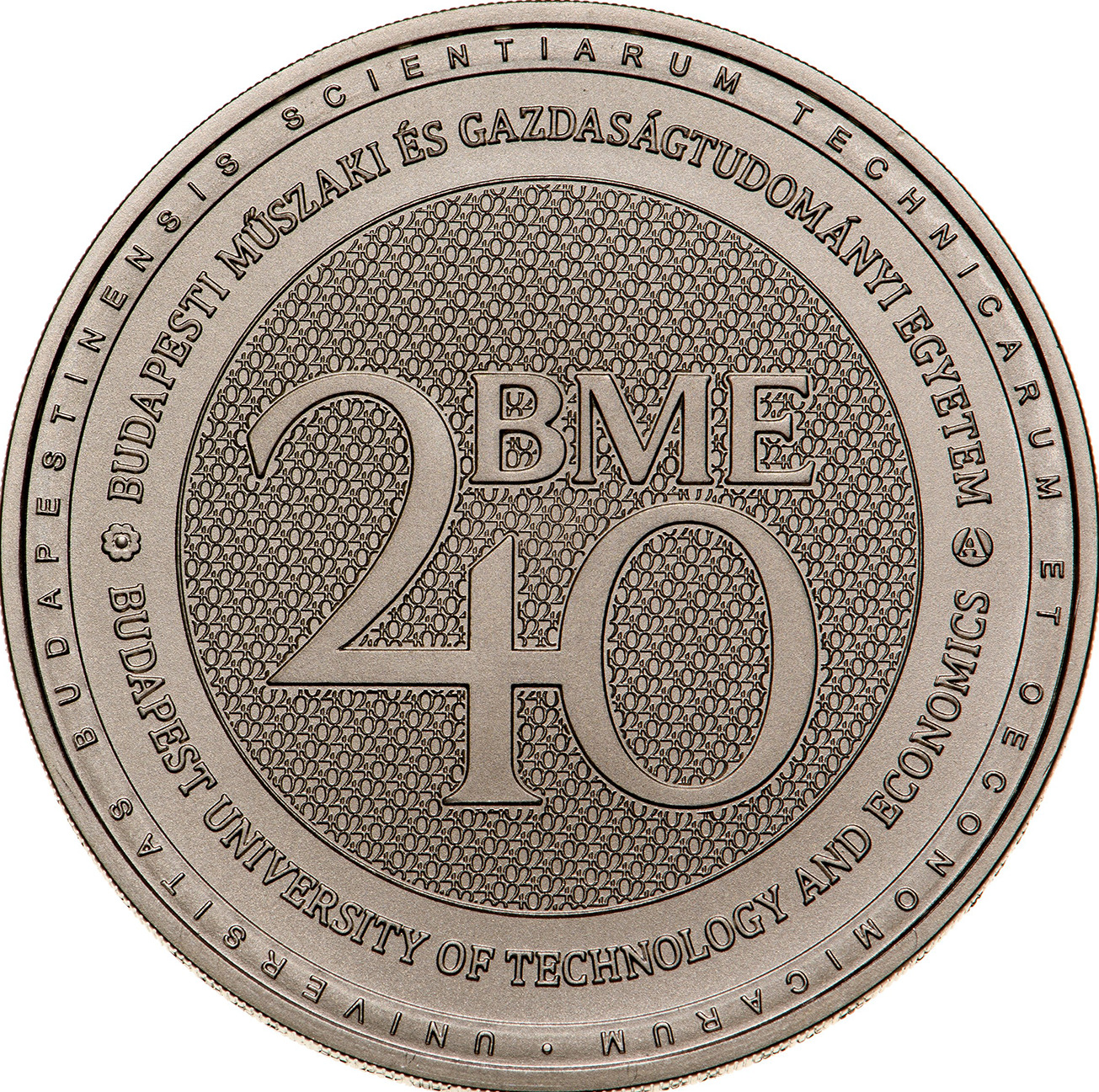The Magyar Nemzeti Bank is issuing a silver collector coin with a face value of HUF 15,000 and its non-ferrous metal version of HUF 2,000 to mark the 240th anniversary of the foundation of Budapest University of Technology and Economics in the main building of the university. The collector coin was designed by artist András Szilos. Following the event, experts from the Magyar Nemzeti Bank (MNB) and the Budapest University of Technology and Economics (BME) discussed current issues relating to the sustainable economy and the possibilities of green investments in a roundtable discussion based on the research results of the BME and the MNB Green Economy Workshop.
Today, the Magyar Nemzeti Bank is issuing a silver collector coin with a face value of HUF 15,000 and its non-ferrous metal version of HUF 2,000 to mark the 240th anniversary of the foundation of the Budapest University of Technology and Economics.
On the obverse, the frontal representation of a section of the main building of the Budapest University of Technology and Economics is displayed in an asymmetric position. Under the representation, the inscriptions ‘MŰEGYETEM 1782’ (University of Technology, 1782), ‘MAGYARORSZÁG’ (Hungary) referring to the place of the issuance, the denominations ‘15,000’ and ‘2,000’ and the lettering ‘FORINT’, the mint year ‘2022’ and the mint mark ‘BP.’ are featured broken into five lines.
As the central motif of the reverse, the anniversary logo, created to honour the 240 years of the BME, is featured. In the background, the number ‘240’ is seen in multiple images. In the ring around the central motif, in a semi-circular legend, the name of the university is shown at the top and in English at the bottom: ‘BUDAPESTI MŰSZAKI ÉS GAZDASÁGTUDOMÁNYI EGYETEM’ and ‘BUDAPEST UNIVERSITY OF TECHNOLOGY AND ECONOMICS’. The two inscriptions are separated by the stylised representation of a flower ornament on the University sceptre on the left and on the right, by the master mark of metal designer András Szilos, the designer of the coin. A special feature of the collector coin is the inner edge on the reverse showing the name of the University in Latin ‘UNIVERSITAS BUDAPESTINENSIS SCIENTIARUM TECHNICARUM ET OECONOMICARUM’.
The obverse of the Budapesti Műszaki és Gazdaságtudományi Egyetem collector coins
|
Silver collector coin |
Non-ferrous metal collector coin |
The reverse of the Budapesti Műszaki és Gazdaságtudományi Egyetem collector coins
|
Silver collector coin |
Non-ferrous metal collector coin |
Both collector coins have a diameter of 38.61 mm with fine milled edges. On the milled edges, the abbreviations of the departments at the University are seen followed by the year of their foundation: ‘ÉMK 1782 - GPK 1871 - ÉPK 1873 - VBK 1873 - VIK 1949 - KJK 1951 - TTK 1998 - GTK 1998’. The silver coin with a face value of HUF 15,000 is struck in .925 fine silver and weighs 31.46 grams. The non-ferrous metal coin with a face value of HUF 2,000 is produced from an alloy of copper (75%) and nickel (25%) and weighs 30.80 grams. 5,000 pieces can be made of the silver collector coin in proof finish and 5,000 pieces of the non-ferrous version in BU finish.
In order to promote the role of these collector coins to raise awareness as widely as possible, the silver coin ‘Budapesti Műszaki és Gazdaságtudományi Egyetem’ will be available for purchase for three months while stocks last, and the non-ferrous version for one year from the date of issuance, at face value in the webshop (https://www.penzvero.hu/) and coin shop of Hungarian Mint Ltd. (Budapest, distr. V, 7 Báthory street), the producer and the distributor of the coins, starting from 20 April 2022.
At the roundtable discussion following the ceremonial presentation of the commemorative coins, the representatives of BME and the MNB discussed issues relating to the green economy, green finances and the sustainability and energy independence of energy production and energy markets based on the results of joint research. Barnabás Virág, Deputy Governor of the Magyar Nemzeti Bank, shared his thoughts on the central bank's green monetary policy strategy and "green mandate", as well as the challenges of long-term sustainable growth. Dr Elvira Böcskei, Associate Professor at the Faculty of Economics and Social Sciences of BME, presented the university's green financial research projects, highlighting the positive role of green bonds in corporate sustainability. Dr Attila Aszódi, Professor, Dean of the Faculty of Science at BME and Dr Péter Kaderják, Head of the Zero Carbon Center of BME, focused on Hungary's goal of climate neutrality and the possibilities and limitations of renewable energy production and nuclear energy in connection with the Russian-Ukrainian conflict. Dr Gábor Gyura, Head of the Sustainable Finance Department of the MNB, emphasised that, compared to Western Europe, in Hungary green finances are still at an early stage, but the university itself can contribute to the strengthening of green financing.
The Institutum Geometrico Hydrotechnicum, the earliest predecessor institution of this university, playing a central role among the Institutes of Technology, was founded in 1782. Training engineers, the Institutum was the first civic institution in Europe in the 18th century offering engineer training. The primary task of the University of Technology is to train technical, IT, natural science specialists and experts in economy, business and management. Inseparable from training, the BME’s mission is promoting scientific research, encompassing basic and applied research, technological product and service development and the utilisation of the results which all constitute the innovation chain. According to the latest assessment performed by one of the most significant analyst companies in the world, the British Quacquarelli Symonds (QS), the BME was the number one institution offering a training in engineering and technology in Hungary in 2022.
The MNB has had a major partnership programme with the Budapest University of Technology and Economics since 2019. This partnership is characterised by continued growth, and the achieved results are increasing in number and becoming more detailed year after year. In the beginning, joint research focussed on only the two major areas of green finances and digitalisation, artificial intelligence. This scope has been widened adding the subject of higher-education innovation this year. In addition to education development, organising different events, developing international relations and making arrangements for academic competitions and scholarship programmes, an important objective of the partnership is to create novel products. As a result, innovative approach and forward-looking concepts will also continuously prevail. The joint effort offers a constant inspiring platform to all the professional participants from both parties.



